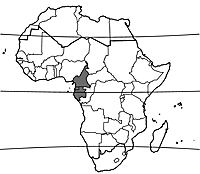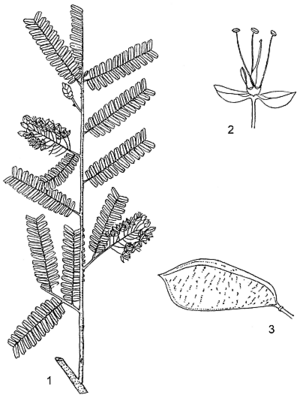Cryptosepalum staudtii (PROTA)
Introduction |
Cryptosepalum staudtii Harms
- Protologue: Bot. Jahrb. Syst. 26: 267 (1899).
- Family: Caesalpiniaceae (Leguminosae - Caesalpinioideae)
Origin and geographic distribution
Cryptosepalum staudtii occurs from Cameroon south to eastern Gabon.
Uses
The wood, known as ‘tani’ or ‘ekop tani’, is suitable for heavy construction, heavy flooring, joinery, interior trim, ship building, vehicle bodies, furniture, railway sleepers, ladders, sporting goods and tool handles.
Production and international trade
The wood of Cryptosepalum staudtii is mainly used locally and rarely traded on the international market.
Properties
The heartwood is pale brown to orange-brown and usually not distinctly demarcated from the up to 15 cm wide, greyish to yellowish white sapwood. The grain is wavy to interlocked, texture moderately coarse. The wood is sometimes slightly glossy.
The wood is heavy, with a density of 890–950 kg/m³ at 12% moisture content, hard and tough. Drying often causes distortion and should be done with care. The rates of shrinkage are high, from green to oven dry 5.5–5.8% radial and 10.4–11.5% tangential. It is recommended to quarter-saw logs before drying. At 12% moisture content, the modulus of rupture is 189–210 N/mm², modulus of elasticity 15,090–16,950 N/mm², compression parallel to grain 73–83 N/mm², shear 10–13.5 N/mm², cleavage 22–24 N/mm and Chalais-Meudon side hardness 6.5–10.2.
The wood is difficult to saw and work with both hand and machine tools; considerable power is required and the wood has rather serious blunting effect on saw teeth and cutting edges. The interlocked grain may cause problems in obtaining a smooth finish. Pre-boring is needed for nailing. The wood splits easily. It takes varnish and paint well. It is moderately durable, being susceptible to marine borers and occasionally to termites. The sapwood is susceptible to Lyctus attack. The heartwood is very resistant to impregnation with preservatives and the sapwood moderately resistant.
Description
- Deciduous, small to medium-sized tree up to 25(–35) m tall; bole branchless for up to 15(–20) m, usually straight and cylindrical, up to 100(–120) cm in diameter, usually without buttresses; bark surface smooth, pinkish grey, inner bark fibrous, reddish pink; twigs glabrous.
- Leaves alternate, paripinnately compound with 10–13 pairs of leaflets; stipules linear, fused at base, caducous; rachis finely hairy; leaflets opposite, sessile, oblong, 1–1.5 cm × 3–4 mm, usually truncate at base, rounded or slightly notched at apex, glabrous, often with a translucent glandular dot near base, pinnately veined.
- Inflorescence a short terminal raceme, usually on lateral twig.
- Flowers bisexual, zygomorphic, whitish, with 2 concave bracteoles 5–6 mm long, enclosing bud, persistent; pedicel up to 8 mm long; calyx with c. 1 mm long tube and usually 4 small teeth; petal 1, elliptical, up to 6 mm long; stamens 3, c. 6 mm long; ovary superior, ellipsoid, with stipe, nearly glabrous.
- Fruit an obovate to oblong, flattened pod 6–8 cm × 3 cm, pointed at apex, smooth with thickened edges, greyish brown, dehiscing with 2 woody valves, 1–2-seeded.
- Seeds rounded, flattened, brown.
Other botanical information
Cryptosepalum comprises about 11 species and is restricted to tropical Africa. It seems most closely related to Paramacrolobium.
Cryptosepalum tetraphyllum
Cryptosepalum tetraphyllum (Hook.f.) Benth. is a small to medium-sized tree, occasionally up to 30 m tall with straight, cylindrical bole up to 80 cm in diameter. It is characterized by 4 leaflets per leaf, the basal ones smaller. It occurs in West Africa, from Guinea to Ghana. Its wood, described as whitish to pinkish and of rather poor quality, is sometimes used in construction although difficult to nail.
Anatomy
Wood-anatomical description (IAWA hardwood codes):
- Growth rings: 2: growth ring boundaries indistinct or absent.
- Vessels: 5: wood diffuse-porous; 13: simple perforation plates; 22: intervessel pits alternate; 23: shape of alternate pits polygonal; 26: intervessel pits medium (7–10 μm); 29: vestured pits; 30: vessel-ray pits with distinct borders; similar to intervessel pits in size and shape throughout the ray cell; 42: mean tangential diameter of vessel lumina 100–200 μm; 46: ≤ 5 vessels per square millimetre; 47: 5–20 vessels per square millimetre; 58: gums and other deposits in heartwood vessels.
- Tracheids and fibres: 61: fibres with simple to minutely bordered pits; 66: non-septate fibres present; 69: fibres thin- to thick-walled; 70: fibres very thick-walled.
- Axial parenchyma: 80: axial parenchyma aliform; (81: axial parenchyma lozenge-aliform); (82: axial parenchyma winged-aliform); 83: axial parenchyma confluent; 89: axial parenchyma in marginal or in seemingly marginal bands; 91: two cells per parenchyma strand; 92: four (3–4) cells per parenchyma strand; 93: eight (5–8) cells per parenchyma strand.
- Rays: 97: ray width 1–3 cells; 104: all ray cells procumbent; (106: body ray cells procumbent with one row of upright and/or square marginal cells); 115: 4–12 rays per mm.
- Secretory elements and cambial variants: 131: intercellular canals of traumatic origin.
- Mineral inclusions: 136: prismatic crystals present; 142: prismatic crystals in chambered axial parenchyma cells; (143: prismatic crystals in fibres).
Growth and development
In Gabon Cryptosepalum staudtii usually flowers in September–October when also young leaves develop; the trees with their white flowers mixed with pinkish young leaves are then very attractive. The young leaves are eaten by monkeys, chimpanzees, gorillas and elephants. Fruits ripen in January–February; they open explosively with a sharp crack, dispersing the seeds over short distances.
Ecology
Cryptosepalum staudtii occurs in lowland evergreen rainforest, often along rivers.
Genetic resources
Cryptosepalum staudtii has a limited distribution area and it seems fairly uncommon in most parts of its range. At present, there are no indications of threats by genetic erosion, but it might easily become threatened when logging becomes more intensive.
Prospects
Despite its good timber properties, there is too little information on many aspects of Cryptosepalum staudtii to assess its prospects as a commercial timber source. Further research on its growth and proper management in natural forest is warranted.
Major references
- Aubréville, A., 1970. Légumineuses - Césalpinioidées (Leguminosae - Caesalpinioideae). Flore du Cameroun. Volume 9. Muséum National d’Histoire Naturelle, Paris, France. 339 pp.
- Bolza, E. & Keating, W.G., 1972. African timbers: the properties, uses and characteristics of 700 species. Division of Building Research, CSIRO, Melbourne, Australia. 710 pp.
- Burkill, H.M., 1995. The useful plants of West Tropical Africa. 2nd Edition. Volume 3, Families J–L. Royal Botanic Gardens, Kew, Richmond, United Kingdom. 857 pp.
- Keay, R.W.J., Hoyle, A.C. & Duvigneaud, P., 1958. Caesalpiniaceae. In: Keay, R.W.J. (Editor). Flora of West Tropical Africa. Volume 1, part 2. 2nd Edition. Crown Agents for Oversea Governments and Administrations, London, United Kingdom. pp. 439–484.
- Takahashi, A., 1978. Compilation of data on the mechanical properties of foreign woods (part 3) Africa. Shimane University, Matsue, Japan. 248 pp.
- Vivien, J. & Faure, J.J., 1985. Arbres des forêts denses d’Afrique Centrale. Agence de Coopération Culturelle et Technique, Paris, France. 565 pp.
- White, L. & Abernethy, K., 1997. A guide to the vegetation of the Lopé Reserve, Gabon. 2nd edition. Wildlife Conservation Society, New York, United States. 224 pp.
Other references
- Aubréville, A., 1968. Légumineuses - Caesalpinioidées (Leguminosae - Caesalpinioideae). Flore du Gabon. Volume 15. Muséum National d’Histoire Naturelle, Paris, France. 362 pp.
- Hawthorne, W. & Jongkind, C., 2006. Woody plants of western African forests: a guide to the forest trees, shrubs and lianes from Senegal to Ghana. Kew Publishing, Royal Botanic Gardens, Kew, United Kingdom. 1023 pp.
- Lewis, G., Schrire, B., MacKinder, B. & Lock, M., 2005. Legumes of the world. Royal Botanic Gardens, Kew, Richmond, United Kingdom. 577 pp.
- Normand, D. & Paquis, J., 1976. Manuel d’identification des bois commerciaux. Tome 2. Afrique guinéo-congolaise. Centre Technique Forestier Tropical, Nogent-sur-Marne, France. 335 pp.
- Sallenave, P., 1955. Propriétés physiques et mécaniques des bois tropicaux de l’Union française. Centre Technique Forestier Tropical, Nogent sur Marne, France. 129 pp.
- Sallenave, P., 1964. Propriétés physiques et mécaniques des bois tropicaux. Premier supplément. Centre Technique Forestier Tropical, Nogent-sur-Marne, France. 79 pp.
- Voorhoeve, A.G., 1979. Liberian high forest trees. A systematic botanical study of the 75 most important or frequent high forest trees, with reference to numerous related species. Agricultural Research Reports 652, 2nd Impression. Centre for Agricultural Publishing and Documentation, Wageningen, Netherlands. 416 pp.
Sources of illustration
- Aubréville, A., 1968. Légumineuses - Caesalpinioidées (Leguminosae - Caesalpinioideae). Flore du Gabon. Volume 15. Muséum National d’Histoire Naturelle, Paris, France. 362 pp.
Author(s)
- J.R. Cobbinah, Forestry Research Institute of Ghana (FORIG), University P.O. Box 63, KNUST, Kumasi, Ghana
- E.A. Obeng, Forestry Research Institute of Ghana (FORIG), University P.O. Box 63, KNUST, Kumasi, Ghana
Correct citation of this article
Cobbinah, J.R. & Obeng, E.A., 2011. Cryptosepalum staudtii Harms. [Internet] Record from PROTA4U. Lemmens, R.H.M.J., Louppe, D. & Oteng-Amoako, A.A. (Editors). PROTA (Plant Resources of Tropical Africa / Ressources végétales de l’Afrique tropicale), Wageningen, Netherlands.
Accessed 4 April 2025.
- See the Prota4U database.


